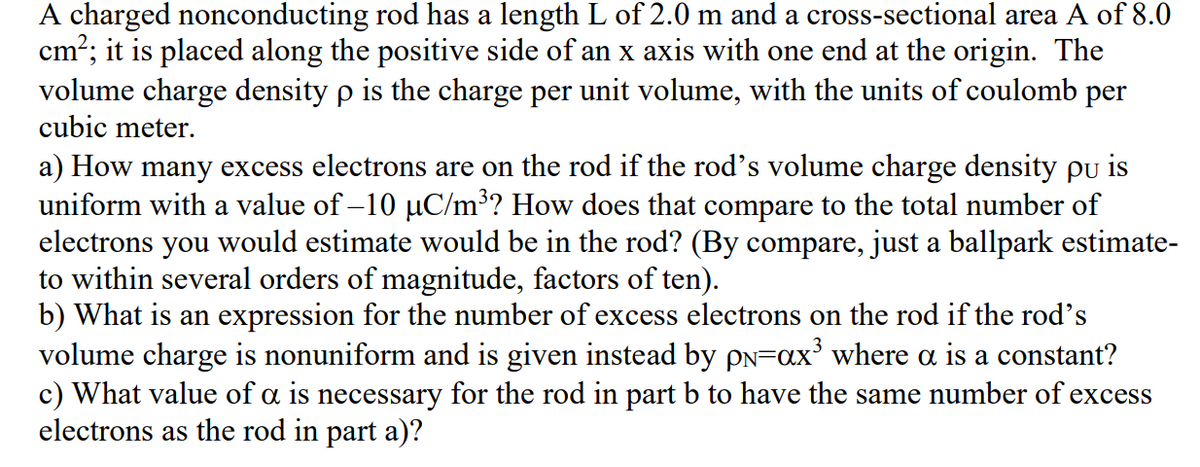A charged nonconducting rod has a length L of 2.0 m and a cross-sectional area A of 8.0 cm?; it is placed along the positive side of an x axis with one end at the origin. The volume charge density p is the charge per unit volume, with the units of coulomb per cubic meter. a) How many excess electrons are on the rod if the rod's volume charge density pu is uniform with a value of –10 µC/m³? How does that compare to the total number of electrons you would estimate would be in the rod? (By compare, just a ballpark estimate- to within several orders of magnitude, factors of ten). b) What is an expression for the number of excess electrons on the rod if the rod's volume charge is nonuniform and is given instead by pN=ax³ where a is a constant? c) What value of a is necessary for the rod in part b to have the same number of excess electrons as the rod in part a)?
A charged nonconducting rod has a length L of 2.0 m and a cross-sectional area A of 8.0 cm?; it is placed along the positive side of an x axis with one end at the origin. The volume charge density p is the charge per unit volume, with the units of coulomb per cubic meter. a) How many excess electrons are on the rod if the rod's volume charge density pu is uniform with a value of –10 µC/m³? How does that compare to the total number of electrons you would estimate would be in the rod? (By compare, just a ballpark estimate- to within several orders of magnitude, factors of ten). b) What is an expression for the number of excess electrons on the rod if the rod's volume charge is nonuniform and is given instead by pN=ax³ where a is a constant? c) What value of a is necessary for the rod in part b to have the same number of excess electrons as the rod in part a)?
Chapter6: Gauss's Law
Section: Chapter Questions
Problem 52P: A long copper cylindrical shell of inner radius 2 cm and outer radius 3 cm surrounds concentrically...
Related questions
Question

Transcribed Image Text:A charged nonconducting rod has a length L of 2.0 m and a cross-sectional area A of 8.0
cm?; it is placed along the positive side of an x axis with one end at the origin. The
volume charge density p is the charge per unit volume, with the units of coulomb per
cubic meter.
a) How many excess electrons are on the rod if the rod's volume charge density pu is
uniform with a value of –10 µC/m³? How does that compare to the total number of
electrons you would estimate would be in the rod? (By compare, just a ballpark estimate-
to within several orders of magnitude, factors of ten).
b) What is an expression for the number of excess electrons on the rod if the rod's
volume charge is nonuniform and is given instead by pN=ax³ where a is a constant?
c) What value of a is necessary for the rod in part b to have the same number of excess
electrons as the rod in part a)?
Expert Solution
This question has been solved!
Explore an expertly crafted, step-by-step solution for a thorough understanding of key concepts.
This is a popular solution!
Trending now
This is a popular solution!
Step by step
Solved in 2 steps with 4 images

Knowledge Booster
Learn more about
Need a deep-dive on the concept behind this application? Look no further. Learn more about this topic, physics and related others by exploring similar questions and additional content below.Recommended textbooks for you


Physics for Scientists and Engineers: Foundations…
Physics
ISBN:
9781133939146
Author:
Katz, Debora M.
Publisher:
Cengage Learning


Physics for Scientists and Engineers: Foundations…
Physics
ISBN:
9781133939146
Author:
Katz, Debora M.
Publisher:
Cengage Learning